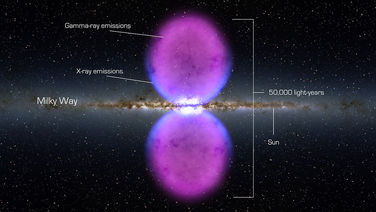The center of the Milky Way was first discovered by Harlow Shapley in 1918. He described the galactic center as a defined region in the direction of the constellation Sagittarius.
But much of the galactic center was shielded from Shapely's view by dust and gas. Its mysteries would only be revealed once we learned how to explore in "invisible light."
Radio waves (which are just another form of "light" in the electromagnetic spectrum) brought the first exciting clue: Radio telescopes revealed a faint radio source in the direction of the predicted galactic core in Sagittarius.
Then, looking in infrared light through the obstructing clouds of gas and dust revealed the stars at the very center of the Milky Way for the first time.
Measurements of their orbits showed they are being gravitationally affected by an object 2.6 million times the mass of the sun. An object with that mass confined in an area less than one-fifth of a light-year across can only be a super-massive black hole.
Recent observations with the orbiting Chandra X-Ray Observatory show that the black hole at the center of our galaxy flares up almost daily with outbursts of x-rays as it gobbles more matter around it. The rays come from particles being expelled at very high speed from the edge of the black hole's intense gravity field.
With studies of other galaxies, astronomers now believe that most, if not all, large galaxies harbor black holes at their centers.
